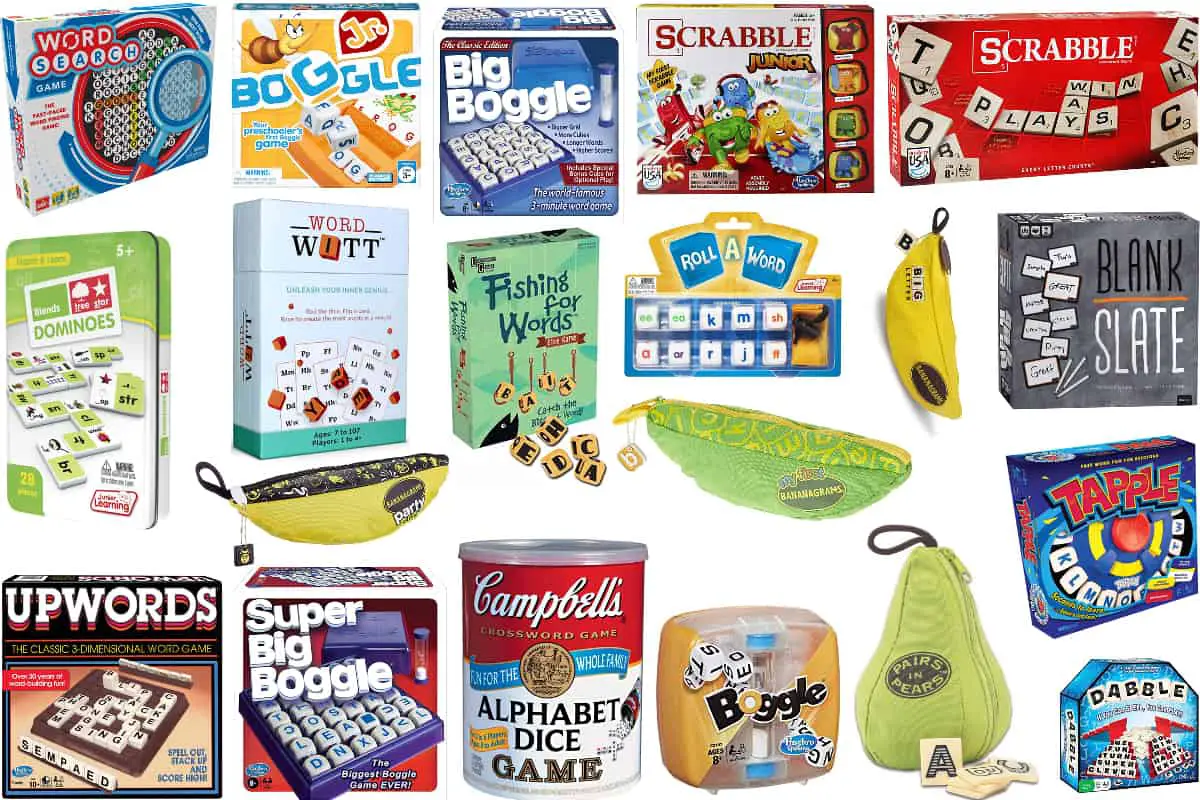This post contains affiliate links.
Word games are very popular. But what is beyond Boggle, Bananagrams, and Scrabble, which are the most weel-known (at least for me)?. Here is what I discovered.
I found 25 word and letter tabletop games that belong in the following categories:
- Letter Board games, for example, Upwords
- Letter Tile games, like Jabuka
- Letter Dice games, such as Fishing for Words
- Word Board games, like Word Search
Tabletop Games Comparison Table
In this comparison table, I arranged the tabletop games according to types so that you can choose right away the best game to play at home or at school.
| Game | Type | Age | Players | For | Price | Rating |
|---|---|---|---|---|---|---|
| Scrabble | Letter Board | 8+ | 2-4 | Families | $$ | ★★★★☆ |
| Scrabble Junior Game | Letter Board | 7+ | 2-4 | Families | $$ | ★★★☆☆ |
| Upwords | Letter Board | 9+ | 2-4 | Families | $$$ | ★★★★☆ |
| Wordigo | Letter Board | 8+ | 2-4 | Families | $ | ★★★☆☆ |
| Appletters | Letter Tiles | 6+ | 1-4 | Families | $ | ★★★★★ |
| Bananagrams | Letter Tiles | 9+ | 2-8 | Families | $$ | ★★★☆☆ |
| Bananagrams Party Edition | Letter Tiles | 9+ | 2-8 | Families | $$ | ★★★★☆ |
| Big Letter Bananagrams | Letter Tiles | 9+ | 1-8 | Families | $$ | ★★★☆☆ |
| Double Bananagrams | Letter Tiles | 9+ | 2-8 | Families, Teachers | $$ | ★★★☆☆ |
| Pairs in Pears | Letter Tiles | 5+ | 2-4 | Families, Teachers | $$ | ★★★★☆ |
| Dabble | Letter Tiles | 10+ | 2-4 | Families | $$$ | ★★★☆☆ |
| Jabuka | Letter Tiles | 3+ | 2-8 | Families, Teachers | $$ | ★★★★★ |
| Oneup | Letter Tiles | 7+ | 2-4 | Families | $$ | ★★★★☆ |
| Bananagrams Duel | Letter Tiles | 7+ | 2 | Families | $ | ★★★★☆ |
| Boggle | Letter Dice | 8+ | 2-4 | Families | $$ | ★★★☆☆ |
| Boggle Junior | Letter Dice | 3-5 | 1-2 | Families | $$ | ★★★★☆ |
| Big Boggle | Letter Dice | 8+ | 2-6 | Families | $$ | ★★★☆☆ |
| Super Big Boggle | Letter Dice | 8+ | 2-6 | Families | $$ | ★★★☆☆ |
| Campbell’s Alphabet Dice | Letter Dice | 8+ | 2-6 | Families | $$ | ★★★☆☆ |
| Fishing for Words | Letter Dice | 8+ | 2-4 | Families | $$ | ★★★☆☆ |
| Roll A Word | Letter Dice | 4-9 | 2 | Families | $ | ★★★★☆ |
| Word for Word | Letter Dice | 7+ | 2-4 | Teachers | $$$ | ★★★★★ |
| Word Spin | Letter Dice | 8+ | 2-10 | Families | $$ | ★★★★★ |
| Blank Slate | Word Board | 8+ | 3-8 | Families | $$$ | ★★★☆☆ |
| Word Search | Word Board | 7+ | 2-4 | Families | $$ | ★★★☆☆ |
Letter Board Games
In this section, I list letter games that have players build words that they already know (by assembling letters). These games are not intended to learn new words, although you might learn some from the words the others are playing. They help learn word orthography though, and are also a way to encourage children to use a dictionary, as they are often used to check is a word is valid.
Scrabble (Hasbro)
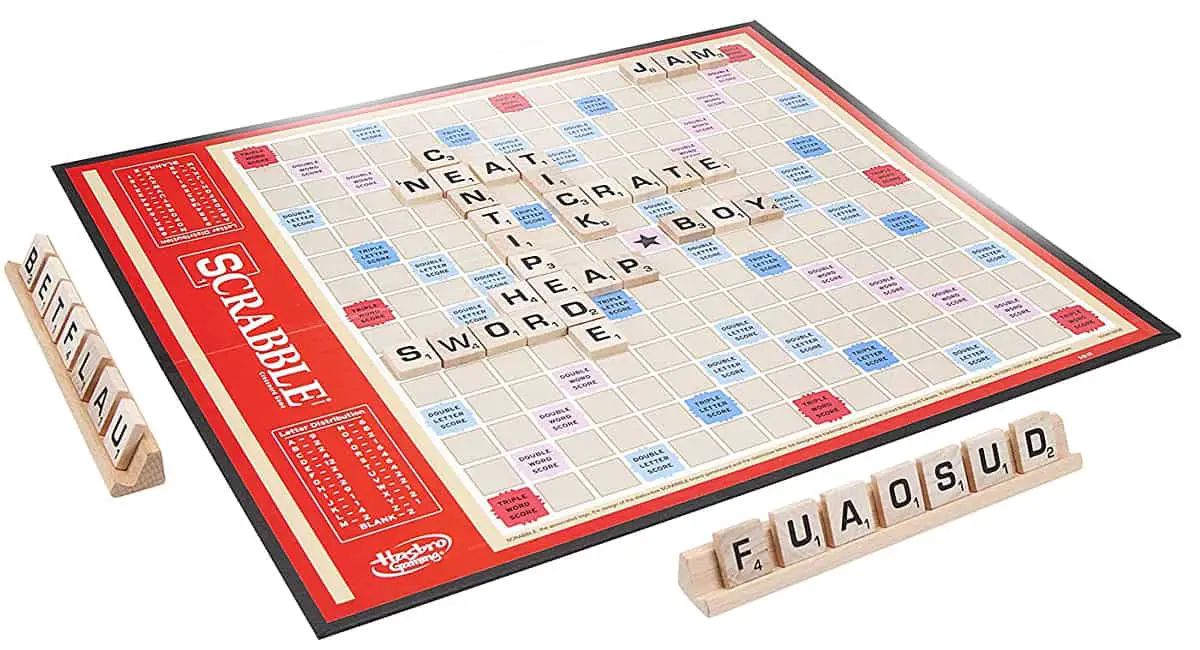
★★★★☆
For Families | Age 8+ | 2-4 Players | Author: Alfred Mosher Butts
Throughout the years, Scrabble remains a top-rated crossword board game that excites players around the world.
remains a top-rated crossword board game that excites players around the world.
In case you have not yet played scrabble :
- The main object of the game is to accumulate the highest score possible by creating words with high-scoring letter tiles and placing them on premium squares onto the gameboard.
- Premium squares are gameboard spaces that multiply the value of the letter or word placed on them (Double letter, Triple letter, Double letter word, Triple Letter word).
Scrabble contains:
- A gameboard, 4 tile holders, A cloth tile bag
- 100 letter tiles (2 of them are blank tiles that stand for any letter)
Old versions (long ago!) were sturdier, heavier (made of quality wood), with letters engraved in gold, but this newer version has bigger tiles (good for seniors who are the most frequent players of Scrabble).
More recent games presented here propose gameplays meant to improve on Scrabble’s shortcomings:
- Waiting for other players’ turn (who typically might think for some time before playing) which causes playing time to be over an hour
- Rare letters score high, which means that to win, players have to use a specific subset of the common vocabulary (pro scrabble players know this list of high scoring words by heart)
Besides, validating words often requires a dictionary, and scoring can sometimes be complicated.
Despite these, scrabble can be played by children aged 8 years old and up because the mechanics are easy to learn, and it enables them to bond with older generations. I highly recommend modifying the scoring in the following way to make it more interesting for children:
- 6 to 8 year-olds multiply the final score by 3
- 9 to 11 year-olds multiply the final score by 2
- 12 to 14 year-olds multiply the final score by 1.5
That way, children have the same odds of winning as adults, and will find the game much more interesting.
Scrabble Junior Game (Hasbro)
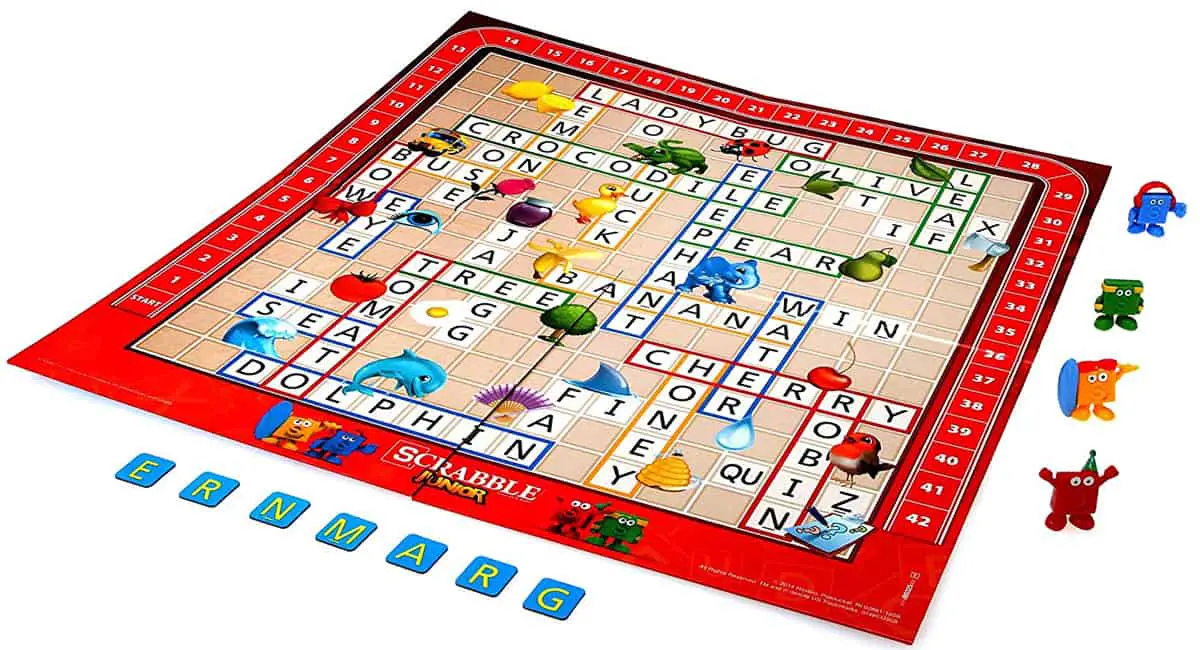
★★★☆☆
For Families | Age 7+ | 2-4 Players
Scrabble Junior Game is a 2-in-1 crossword game where players form words by putting letter tiles onto the game board.
is a 2-in-1 crossword game where players form words by putting letter tiles onto the game board.
It includes four cute playing tokens, 105 letter tiles (not very readable though) and a double-sided gameboard which can be played by beginners and advanced players.
Beginners match the letter tiles to the letters on the gameboard to collect points. These points determine the number of spaces the player’s token moves on the game board. The player with the highest score wins the game.
Advanced players use the other side of the gameboard to play the traditional Scrabble game. However, the twist is there are no extra points on the spaces, making the score easy to calculate. The score of each player is also kept track of by placing the token on a track (that removes the need for scoresheets or for remembering each player’s score).
7 or 8 year-olds can play the game for beginners.
I like the design of the gameboard, its illustrations and the game pieces because they are stimulating for children.
Other benefits of the gameplay for beginners include:
- They will learn the correct spelling of words by matching their letter tiles to the letters onto the gameboard.
- They will be familiar with varying word lengths and letter combinations.
Its major disadvantage is that the game becomes dull after several plays because the words on the beginner’s gameboard are always the same (there are only 25 words).
Upwords (Winning Moves)
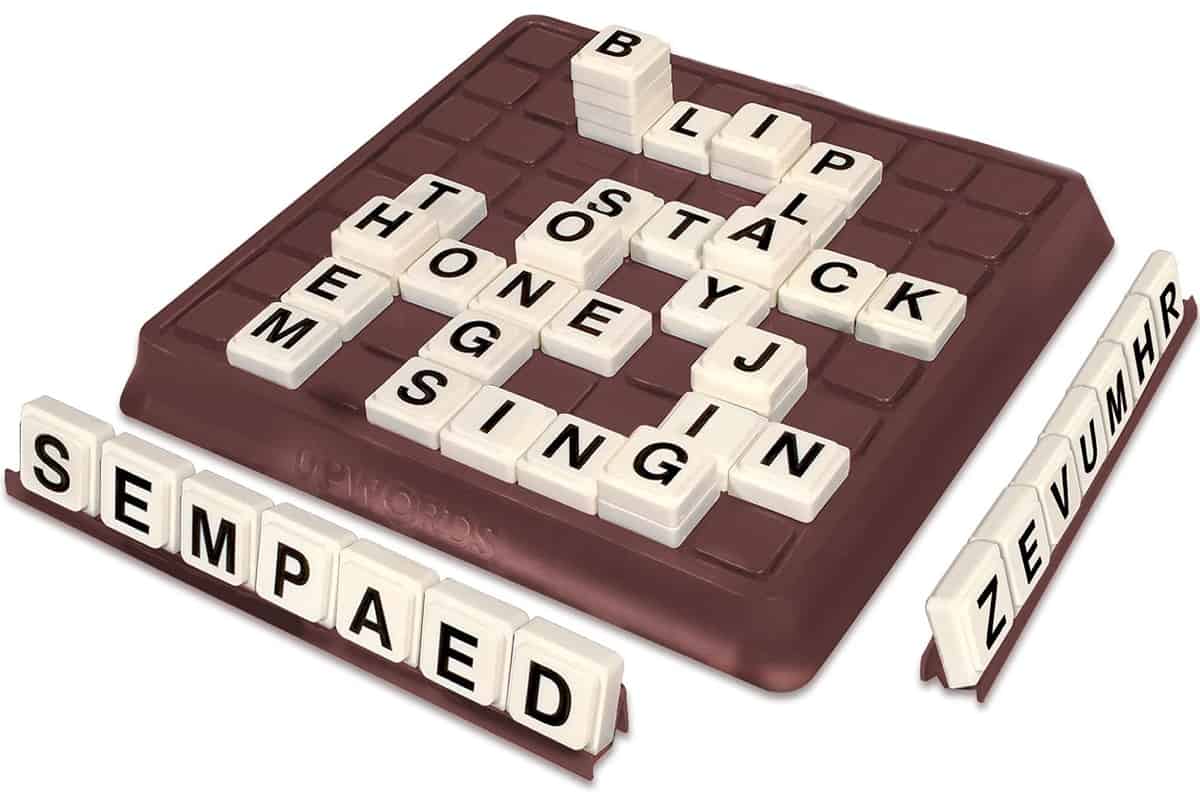
★★★☆☆
For Families | Age 9+ | 2-4 Players | Author: Elliot Rudell
Upwords has been in the market since 1983.
has been in the market since 1983.
This game contains 64 letter tiles, a gameboard grid, 4 tile risers, a plastic storage bag and an instruction guide.
The goal of the game is to stack letters on top of played words on the grid to score more points. If you are used to Scrabble, scoring in this game can be a little challenging. That is why it may take more than 30 minutes to finish the game.
Despite that, this game is good for exercising the mind because it encourages players to
- Challenge themselves to build a 7-letter word or use 2-letter words
- Think of a new word by adding letter tiles on top (this inspires players to learn other word formations, paronyms and meanings)
- Practice spelling
- Avoid plurals (this prevents players from being lazy with words)
I like this game because it is forgiving or not intimidating (players may get inspiration from played words or they can pass a turn if they cannot create a word which is great for beginners)
Overall, I recommend this game to children aged 9 years old and up because the gameplay allows them to
- be creative with words
- maximize the words they know for a certain word formation or letter order
- Talk indirectly about different parts of speech
- Learn new word formations and adopt them in the next game.
By the way, this game had national tournaments in Hungary and Turkey.
Wordigo (River Edge Game Company)
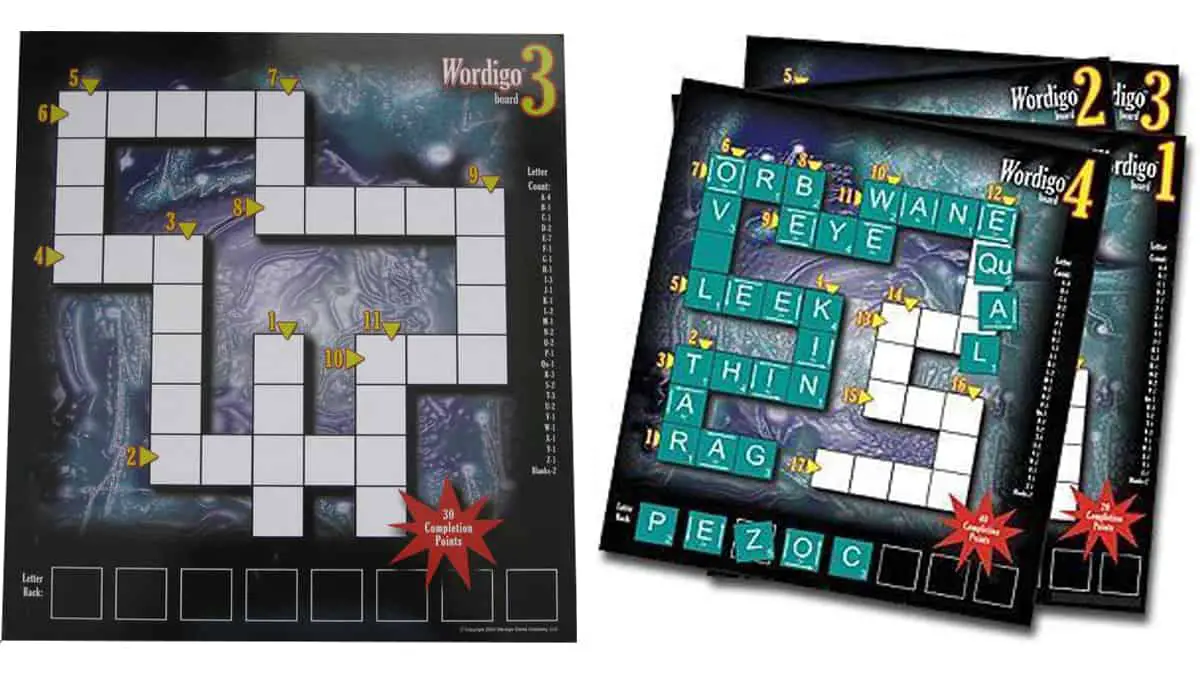
★★★☆☆
For Families | Age 8+ | 2-4 Players
All players can play at the same time in Wordigo. Their focus is on building words before the timer runs out.
Their focus is on building words before the timer runs out.
This game includes
- 4 sets of tiles (49 tiles per set)
- 4 drawstring letter bags
- 8 gameboards (2 copies for each design, there are 4 designs)
- Rules of play
- A 7-minute sand timer
- A score pad
It only takes 7 minutes to finish each round and 30 minutes to complete the whole game. The player with the highest score after three rounds wins the game.
This game is unique because
- The designs of the gameboards determine the difficulty of the gameplay (Players can choose how to progress in the game)
- Matches are available for solo and multiplayer games
Therefore, this game teaches players to:
- Spell words correctly (dictionaries are allowed)
- Strategize in using consonants and vowels to score high points (it’s difficult to decide because consonants carry points and vowels are multipliers)
I recommend this game to be played with adults because scoring can be a little confusing. It may take a while to get used to the arrows that must be followed for each path.
Letter Tile Games
Appletters (Bananagrams)
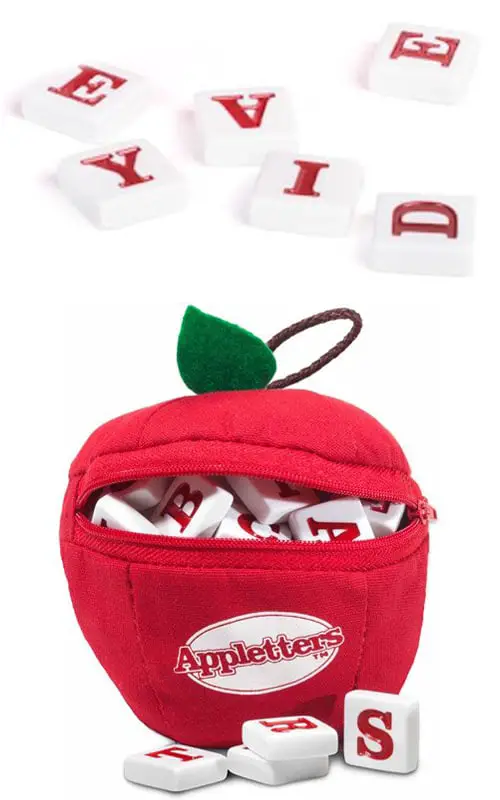
★★★★★
For Families and Teachers | Age 6+ | 1-4 Players
In Appletters, players race to get rid of all the tiles they were dealt with by building a word and adding them at the beginning or the end of the played word.
players race to get rid of all the tiles they were dealt with by building a word and adding them at the beginning or the end of the played word.
This game has 110 letter tiles and a red apple-shaped storage bag. The letter distribution is as follows:
- 1 tile: J, K, Q , V, W, X, Z
- 2 tiles: B, C, F, G
- 3 tiles: H, M , U , Y
- 4 tiles: D, P
- 5 tiles: L
- 7 tile: N
- 8 tiles: O, R, S, T
- 9 tiles: I
- 10 tiles: A
- 12 tiles: E
At the start of the game, each player gets a total of eight letter tiles. The remaining tiles are referred to as the CORE wherein when players fail to build a word, they must pick 3 tiles from it and shout “PICK and PASS”.
To dispose of the letter tiles, players must build a word that can be connected to the first or last letter of the word formed by the previous player.
In the process, players take turns in creating words that can be read horizontally or vertically like a word snake.
The first player to use all the tiles must shout “How do you like them Apples?” and is the winner.
Appletters:
- Is easy to set up and store
- Includes three levels of gameplay (for younger players, removing difficult tiles like Q, W, X and Z makes the game more fun)
- Has easy mechanics
- Enables inexperienced players to use a dictionary while waiting for their turn
- Has rules that can be modified for better gameplay and to encourage interaction among players. For example, allow trading tiles among players.
Compared to other Bananagrams’ games, Appletters is more player-friendly for children because:
- The letters are neatly printed in bold red ink against white background which makes the letters appear larger
- The letter tiles are thicker which enables to put them standing (so that other players do not see your tiles and cannot anticipate what you are going to do)
- All players play on the same word list – this is more interactive and enjoyable
There is also a version of Appletters that contains letter tiles made of cardboard kept in a storage box instead of a pouch.
Bananagrams (Bananagrams)
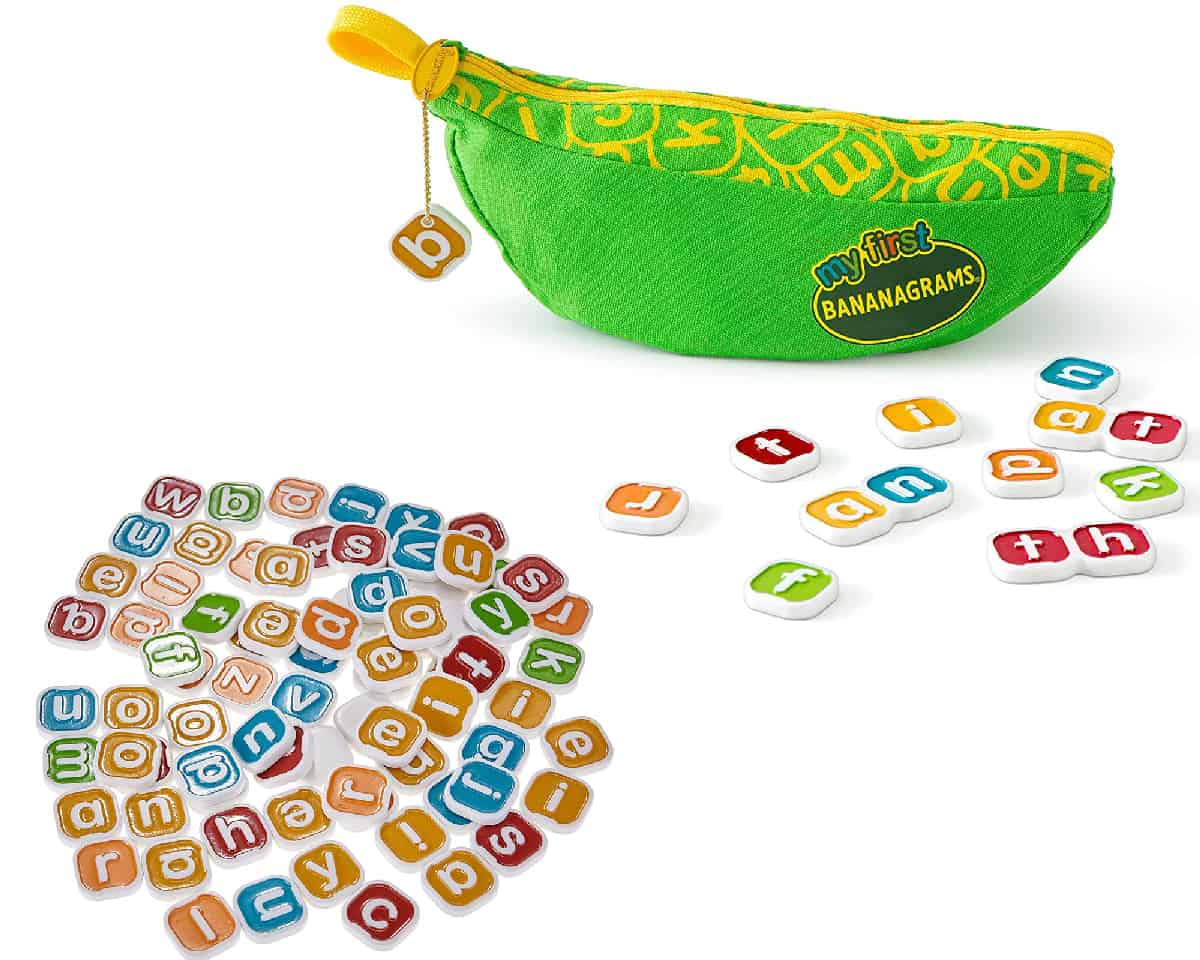
★★★☆☆
For Families and Teachers | Age 9+ | 2-8 Players | Author: Abraham Nathanson
Bananagrams has had a lot of success since it was launched in January 2006. It is composed of 144 tiles but unlike other games published by the same manufacturer, this original game scores highly in:
has had a lot of success since it was launched in January 2006. It is composed of 144 tiles but unlike other games published by the same manufacturer, this original game scores highly in:
- Replayability
- Opportunity for gameplay variation (the game guide offers alternative ways of playing the game)
Players work independently as they form a grid of vertical and horizontal words, connected to each other.
Players have each their own tiles and the remaining are face down in the center of the table. This pile is called the BUNCH. There are two important ACTIONS:
- DUMPING- Every time a player wants to return the letter back to the bunch, the player shouts DUMP and gets three tiles from the bunch. This move does not affect other players.
- PEELING- When a player calls out PEEL, all players must get a tile from the bunch
The object of the game is to get rid of all the tiles in the bunch. The first player with no remaining tiles is the winner of the game, and shouts “BANANAS”. He wins if all the words are valid – else he is a “ROTTEN BANANA” and out of the game.
What I like the most about Bananagrams is that players can freely rearrange their letters and that there is no scoring.
Overall, Bananagrams is a great game.
- at home with children aged 9 years old and up (too competitive before that, and in any case competition with adults would be too difficult)
- as reinforcement activity in school for children aged 10 years old and up.
Bananagrams Party Edition (Bananagrams)

★★★★☆
For Families | Age 9+ | 2-8 Players
Just like the other Bananagrams, the main goal of Bananagrams Party Edition is to be the first player to use all the tiles in building a crossword grid. The catch is players are presented with 14 superpower tiles on top of the original 114 tiles.
is to be the first player to use all the tiles in building a crossword grid. The catch is players are presented with 14 superpower tiles on top of the original 114 tiles.
These 14 special party tiles enable players to choose among their opponents to carry out an action that would slow them down in completing their crosswords, for example:
- Bombastic– If you have one bonb tile, the word grids of your opponents are safe. However, if you draw two bomb tiles, you can destroy an opponent’s word grid so that he’ll start over.
- Single-handed– This tile slows down the chosen opponent because it requires the player to use only one hand in arranging tiles.
- Switcheroo– The player who has this tile switches places with another player and inherits the word grid and party tile action.
- The Re-gifter- Choose three of your loose tiles or from your grid and give them to your chosen opponent.
- The Thief– Players can steal a tile from their opponent’s word grid or a party tile to advance in the game.
- The Shield– This is the most coveted special tile because it protects the player from all the mischiefs in this game except for Bombastic.
The additional tiles
- Make the game funny, more exciting and challenging
- Encourage players to strategize and interact with other players
This version of bananagrams is also competitive and difficult to play with young or weaker players. I suggest giving them party tiles (older players cannot use them) to give them an upper hand, and removing some special tiles, for example:
- Announcer-Player announces each new word made on the opponent’s grid
- Take a Lap– Players run around the table
- Thumbless- Players cannot use their thumb throughout the game
- Spell It –Player spell the word “PEEL” with their hands instead of saying it whenever they exchange their tiles to the bunch.
Another way to encourage slow players is by allowing them to continue the game even when a wrong word was spotted on their grid. Instead of asking the player to step out of the game, the player may remove the invalid word from the grid and fix it.
Compared to Scrabble, it is more enjoyable because you don’t need to count scores.
I highly recommend this game because of the unique experience each player gets each time they play this game. The power tiles are a good source of laughter.
Big Letter Bananagrams (Bananagrams)

★★★☆☆
For Seniors | Age 9+, especially for playing with seniors | 2-8 Players
Big Letter Bananagrams have similar gameplay to the Classic Bananagrams. The only difference is the size of the tiles which are designed to help players with poor vision (larger tiles with letters printed in a thicker font).
have similar gameplay to the Classic Bananagrams. The only difference is the size of the tiles which are designed to help players with poor vision (larger tiles with letters printed in a thicker font).
These letters take up a lot of space.
This game has an interesting backstory. Its development was inspired by an 85-year-old Chicago resident and dedicated Bananagrams player Jan Siemsen. He suffers from Macular Degeneration which is the leading cause of vision loss in the elderly. That’s why a portion of the sales proceeds of this game were donated to American Macular Degeneration Foundation.
Double Bananagrams (Bananagrams)
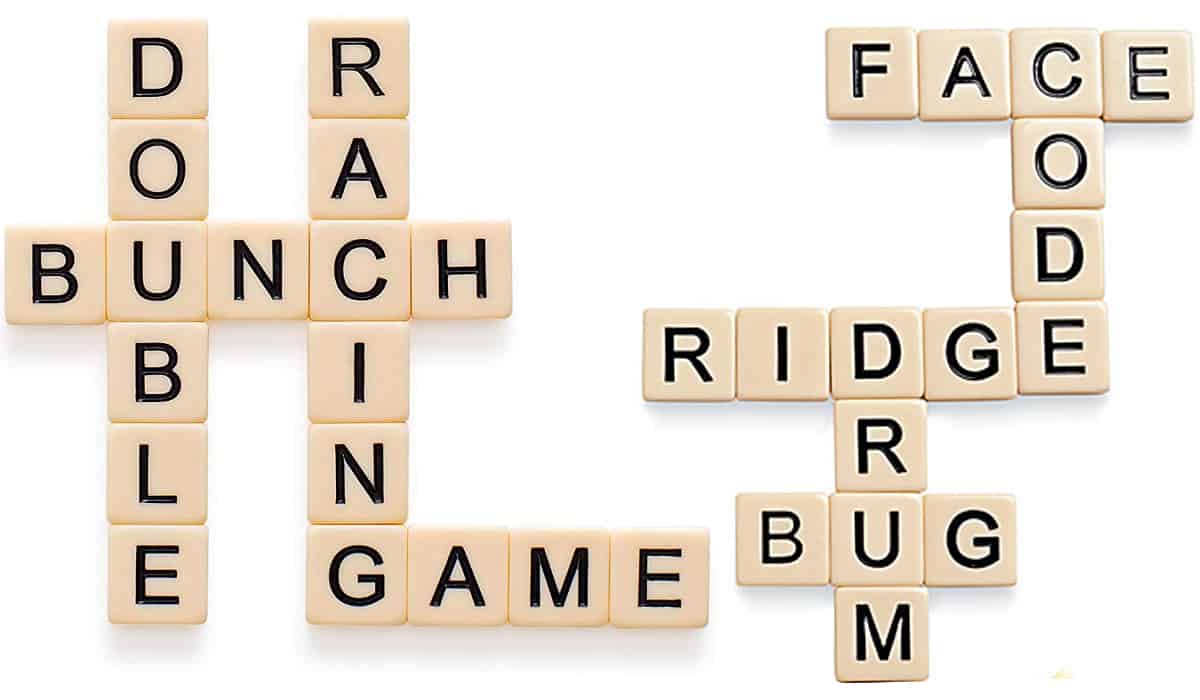
★★★☆☆
For Families and Teachers | Age 9+ | 2-8 Players
Double Bananagrams is a mind-exercising game that can be played solo or with a team composed of 4 players.
is a mind-exercising game that can be played solo or with a team composed of 4 players.
As the name of the game implies, players have twice as many tiles (288) but the gameplay is still the same.
I like that
- The opportunity to build words in varied lengths and combinations is high (more letters, more words)
- The tiles can be used in other games (the instruction guide offers suggestions for game variants)
- The game can be played in family gatherings, camping and as reinforcement activity in classrooms
I have reservations in introducing this game to children younger than 9 years old because they will need help in checking the spelling.
Older children can
- control the length and arrangement of words
- practice various letter combinations
- observe correct spelling
- consult the dictionary to make sure that they construct valid words which lead them to learn the meaning of words indirectly
Pairs in Pears (Bananagrams)
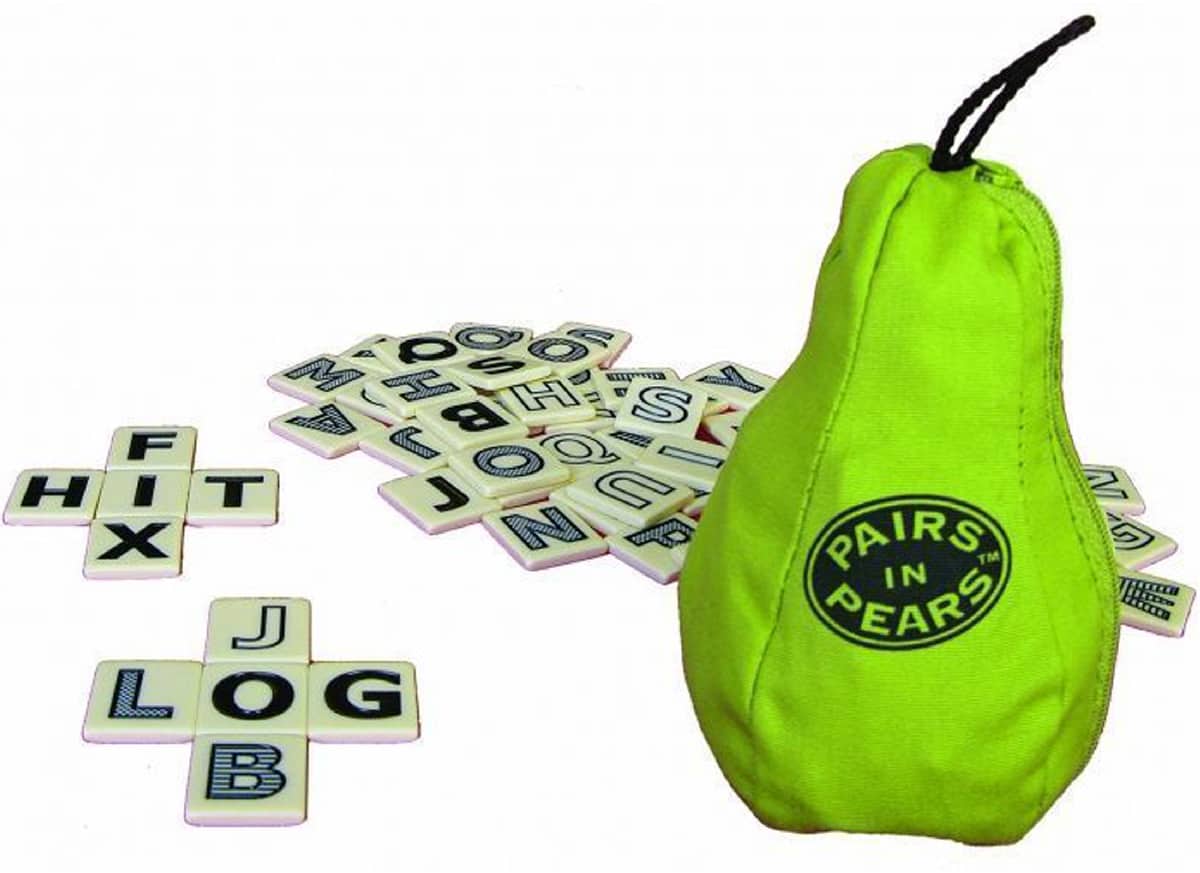
★★★★☆
For Families and Teachers | Age 5+ | 2-4 Players
In Pairs in Pears, patterns are important. Players must make sets of two words that are crossed and use the same letter tile pattern. An alternative is to score more points if the letters all share the same pattern.
patterns are important. Players must make sets of two words that are crossed and use the same letter tile pattern. An alternative is to score more points if the letters all share the same pattern.
Visually, it is interesting to find a complete set of alphabet in four different letter patterns: solid, outline, lines and dots. (a total of 104 plastic tiles).
The instruction leaflet includes activities for Pre-readers (5-6 years old), Beginner readers (6 years old) and advanced readers (8-10 years old) which is great.
All in all, aside from the original gameplay which is good for children aged 8 years old and up, I recommend this game to be played with children aged 6 years old because the letter tiles are useful for studying
- Letter groupings
- Word pairs
- Rhyming words
Dabble (Dabble)

★★★☆☆
For Families | Age 10+ | 2-4 Players | Author: George Weiss
Dabble is a fast-thinking word game that requires players to shout “Dabble” as soon as they finished creating 5 words using 20 tiles.
is a fast-thinking word game that requires players to shout “Dabble” as soon as they finished creating 5 words using 20 tiles.
Players are given 5 minutes to complete these 5 words which must consist of a
- 2 letter word
- 3 letter word
- 4 letter word
- 5 letter word
- 6 letter word
The first player to complete 5 words before the timer runs out is the winner of the round. Losers do not earn any point while the winner gets 25 additional points and the points from the losers’ unused tiles.
The first player to obtain 500 points wins the game.
This game consists of 142 letter tiles and specialty tiles.
- letter tiles carry different numerical values for scoring
- specialty tiles have no point value (includes blank tiles and 2 apostrophe tiles, some players remove them to avoid distraction)
It also comes with 4 tile risers and a 5-minute sand timer.
I like that:
- Players can modify the rules (they can decide how many rounds will they play or how long each round will take.)
- It has extra Spanish alphabet letters (helpful to build Spanish vocabulary)
But scoring is a bit complex. You can play Dabble with children aged 10 years old and up though because
- it offers good practice in creating 2-6 letter words
- Players become familiar with varying letter combinations in different word lengths
- Helps develop spelling skills
Jabuka (Jabuka)
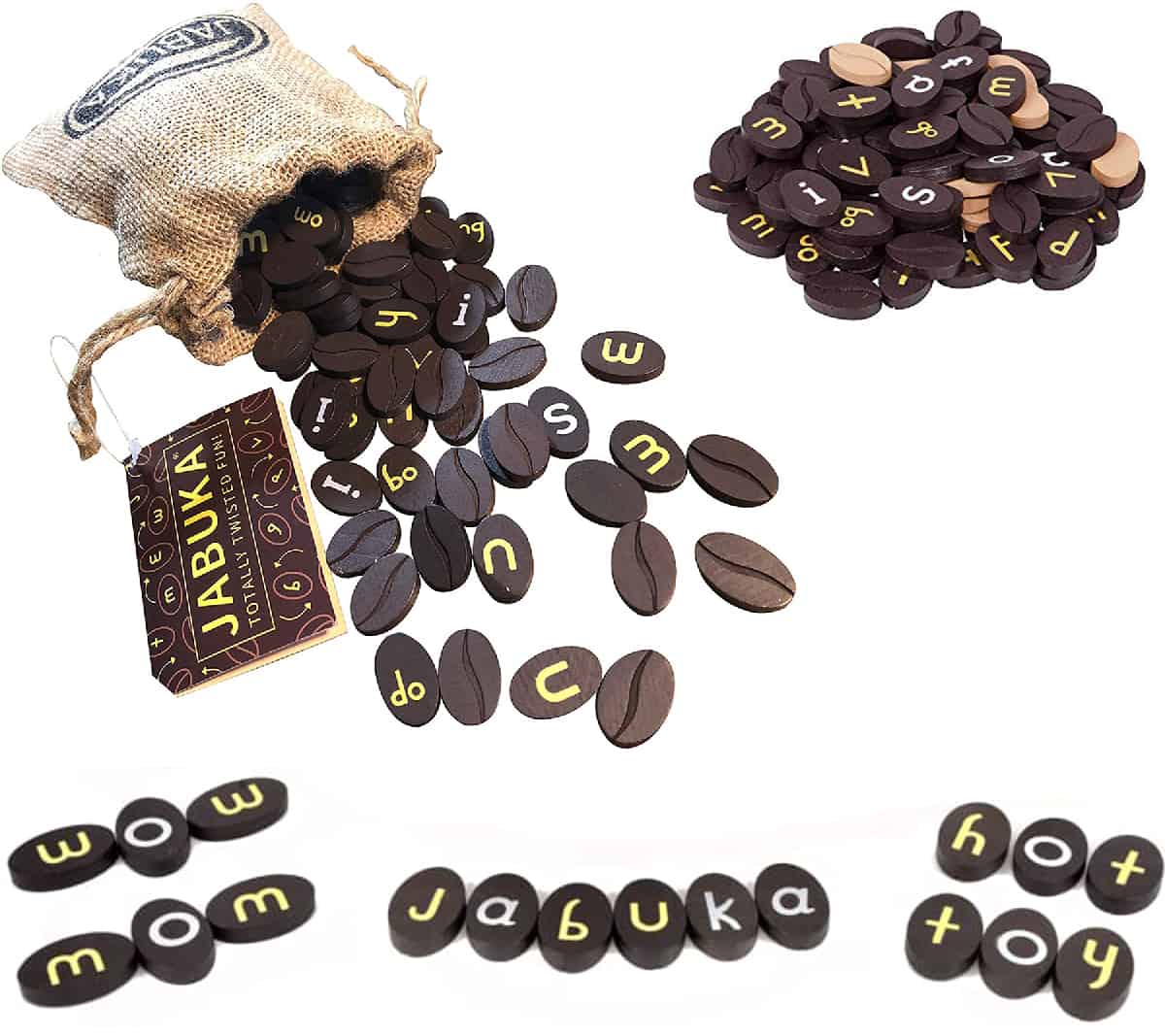
★★★★★
For Families and Teachers | Age 8+ | 2-8 Players | Author: Martin Russocki
Jabuka is a coffee-themed word tile game that features coffee-bean shaped tiles that can be rotated to create words. The player with the most beans at the end of the game is the winner.
is a coffee-themed word tile game that features coffee-bean shaped tiles that can be rotated to create words. The player with the most beans at the end of the game is the winner.
This game contains 100 dark colored beans and 8 light-colored blank beans.
- Blank beans can stand for any letter. Each players gets one at the beginning of the game.
- Some dark beans have yellow letters called “Twisties”, meaning, these letters can be rotated to form new letters. (Example is M which can be rotated and used as E and W.)
- The white letters are used as is.
The three valid actions in building a word in this game are:
- Twist the yellow letters (M for W, d for p)
- Add a letter to a played word
- Rearrange the letters
Players can take the letter tiles from the pile or steal them from an opponent.
I like that:
- The letter rotating is a very original feature of the game, which creates unusual possibilities
- This letter rotating possibility can be used (without the rules, just as an exercise or with much simpler rules) with 3 to 5 year-old children to improve their visual discrimination of letters. At that age, children generally identify objcts visually without a specific direction attached to them. They often cannot discriminate a d and a p which are the same object for them because they are equal if rotated. Besides, the letters have been purposely built for that, which is unique. For that reason, I give 4 stars, but it is for a completely different usage than the author thought!
- The gameplay is easy to understand
- Players can play independently or in a 4 player team
Oneup! (Oneupmanship)
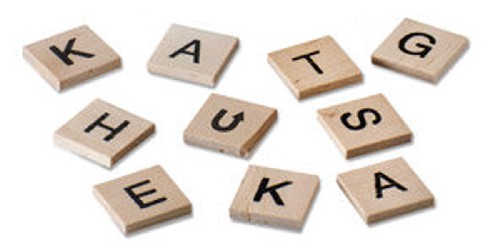
★★★★☆
For Families | Age 7+ | 2-4 Players
Another word game that children aged 7 years old and up can enjoy is Oneup!
In this game, players take turns in flipping one tile at a time to form a word and score points. Each letter is worth one point so scoring is easy.
When all tiles are turned over, the player with the highest score wins the game.
The catch is players are not always lucky in flipping tiles. On top of that, other players can steal their tiles to build a new word.
The game is competitive. I find it better to play with a partner although this game can accommodate 4 players.
In contrast, the good points of this game are
- It allows players to combine words (opportunities for word building is high, from simple words to complex ones)
- Exposes players to compound words, root words and more
- Players become familiar with various letter arrangements and word formations (with just one letter, they can change a word)
- Encourages correct spelling
Letter Dice Games
Bananagrams Duel (Bananagrams)
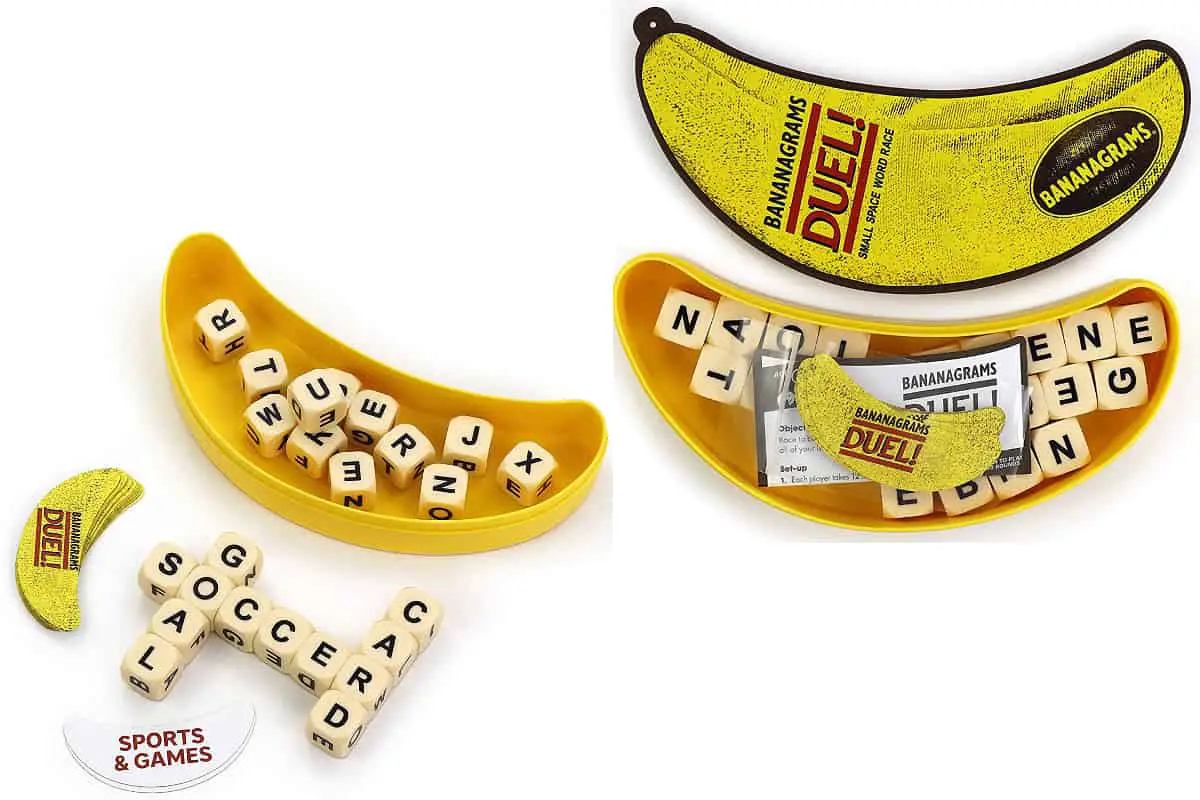
★★★★☆
For Families and Teachers | Age 7+ | 2 Players
Bananagrams Duel features 24 letter cubes that contains 144 letters, 20 banana-themed cards and an instruction guide.
features 24 letter cubes that contains 144 letters, 20 banana-themed cards and an instruction guide.
Pach player takes 12 letter cubes and have one minute to form words that intersect horizontally or vertically.
The first player to use all his 12 cubes wins the round and gets a banana card. The first player to collect 10 banana cards wins the game.
This game is interesting because:
- Players can tweak the rules easily (like setting a longer time limit)
- Dice enable to have more letters available than the same amount of tiles
- You can invent other games for small children like “guess which dice has been changed in a word”, unscramble a word and many more
This game feels like Boggle without a cube grid so there is more freedom to create and rearrange letters.
You can play with children aged 7 years old and up to practice spelling and connecting 2 to 5 words in one minute or more.
Boggle (Hasbro)

★★★☆☆
For Families | Age 8+ | Age 2-4 players | Author: Allan Turoff
Boggle is a classic word game created by Allan Turoff.
is a classic word game created by Allan Turoff.
It includes a 3-minute sand timer, 16 letter dice, a cube grid with dome cover and an instruction guide.
Players have 90 seconds to three minutes to list down words that they can spot from the 16 letter dice shaken inside the cube grid with the dome. Words can be made horizontally, vertically or diagonally. They must be at least 3 letters long.
Similar words do not earn points so players must be able to identify unique words (as many as they can before the timer runs out).
The player with the highest score wins the game.
Here’s how to score points.
- 3-4 letters- 1 point
- 5 letters- 2 points
- 6 letters- 3 points
- 7 letters- 5 points
- 8+ letters- 11 points
Compared to other tabletop games, this has always been neat, compact and a favorite pastime during family gatherings or vacation. The gameplay is easier to learn than Scrabble.
I like that:
- The letters are easy to read
- I can play it alone and set my own goal like beating my previous score
- It can also be played competitively with 3 more players
- The draw is random so every round is different
I recommend introducing this game to children aged 8 years old and up so that they will be exposed to words that have varied formations, letter pairings and length.
Boggle Junior (Hasbro)
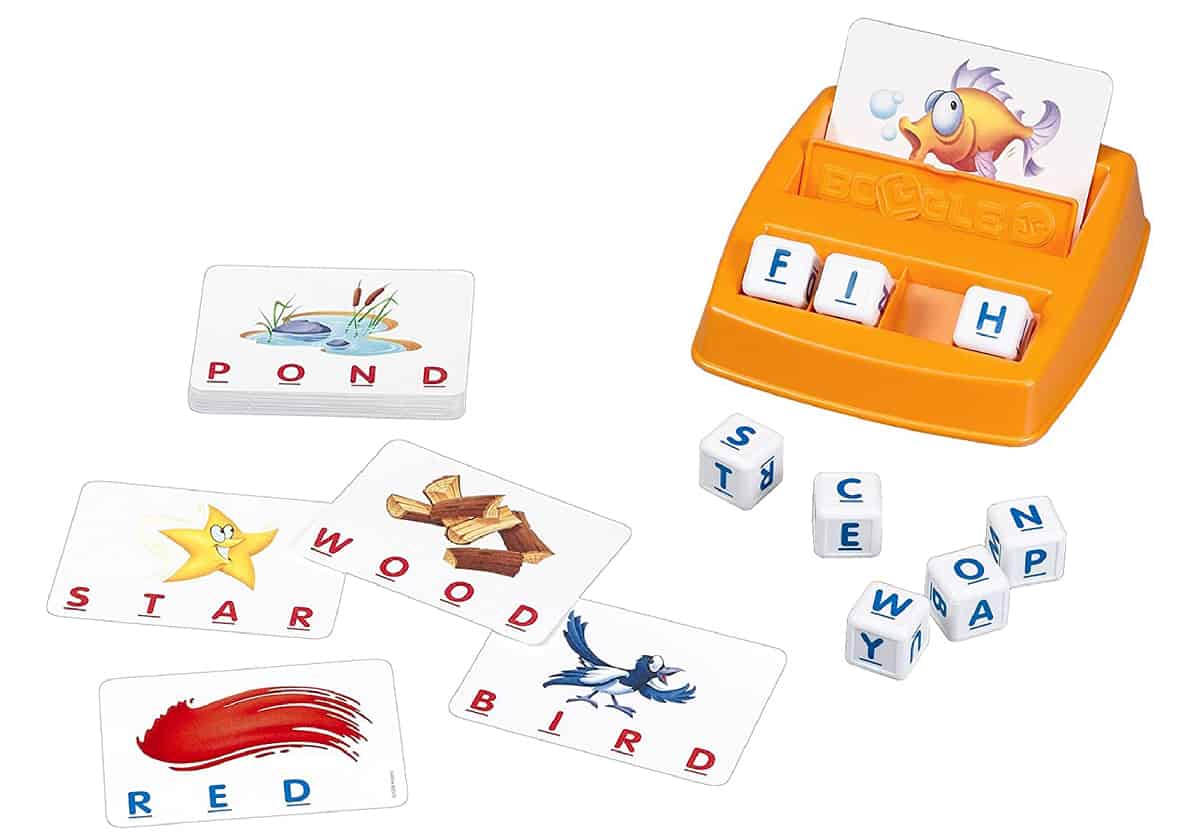
★★★★☆
For Families | Age 3-5 | Age 1-2 Players
Boggle Junior is multi-level game for kids aged 3 to 5 years old. The main goal is to match the pictures with words by spelling out the letters on the game tray using dice.
is multi-level game for kids aged 3 to 5 years old. The main goal is to match the pictures with words by spelling out the letters on the game tray using dice.
When they have mastered this gameplay, they can move on to the variation called “Cover it” where players cover the words and recite the spelling from memory.
This game is comprised of:
- A Game tray
- 30 double-sided picture cards that contain 3 and 4 letter words
- 8 letter dice
- A game guide
I like that Boggle Junior:
- Is self-correcting (Children may review the words as flashcards before challenging themselves to spell the words out either aloud or with dice)
- The game pieces are easy to manipulate
- The picture cards are colorful and appealing to children
- Children may start with 3 letter words first then increase the level of difficulty using 4 letter words and then mix them
Big Boggle (Hasbro)
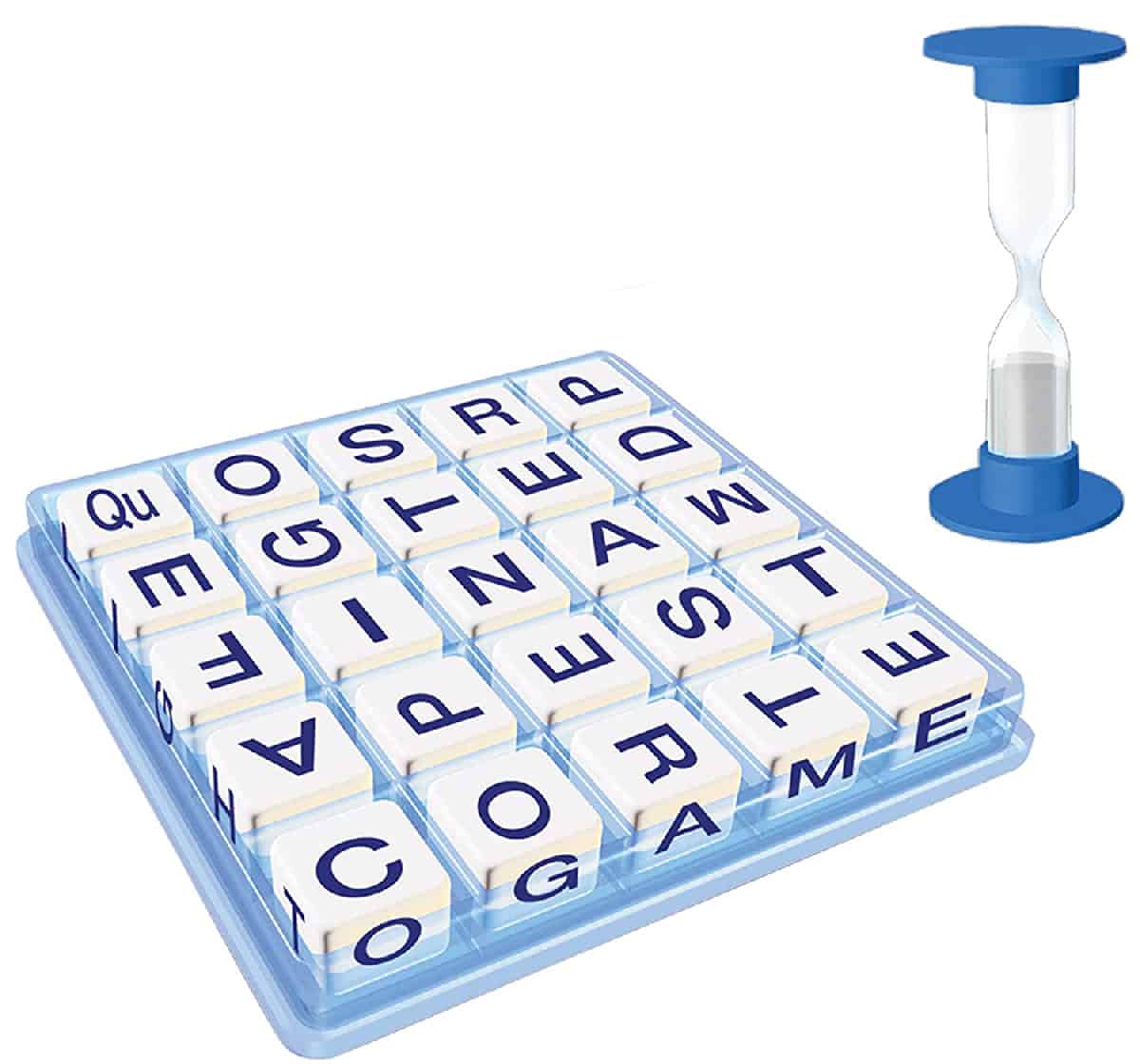
★★★☆☆
For Families | Age 8+ | Age 2-6 players
Big Boggle is a bigger version of the famous 3-minute word game, Boggle. This game uses
is a bigger version of the famous 3-minute word game, Boggle. This game uses
- a 5×5 grid base with lid (the original was 4 x 4)
- a sand timer
- 25 letter dice (from the standard 16 letter dice)
- 1 double letter dice
- Instructions
Compared to the original game, in this version:
- Players start searching for 4 letter words
- more players can participate since the dice and grid are bigger, the letters are more readable for 6 players
- Double letter dice are provided so that players can form more long words. (It features letter combinations such as Qu, Er, In, An, He and Th)
- The letters are painted in blue
You can play with children aged 8 years old and up because the introduction of the double letter dice directs them to be familiar with words that have those letter combinations.
Super Big Boggle (Winning Moves)
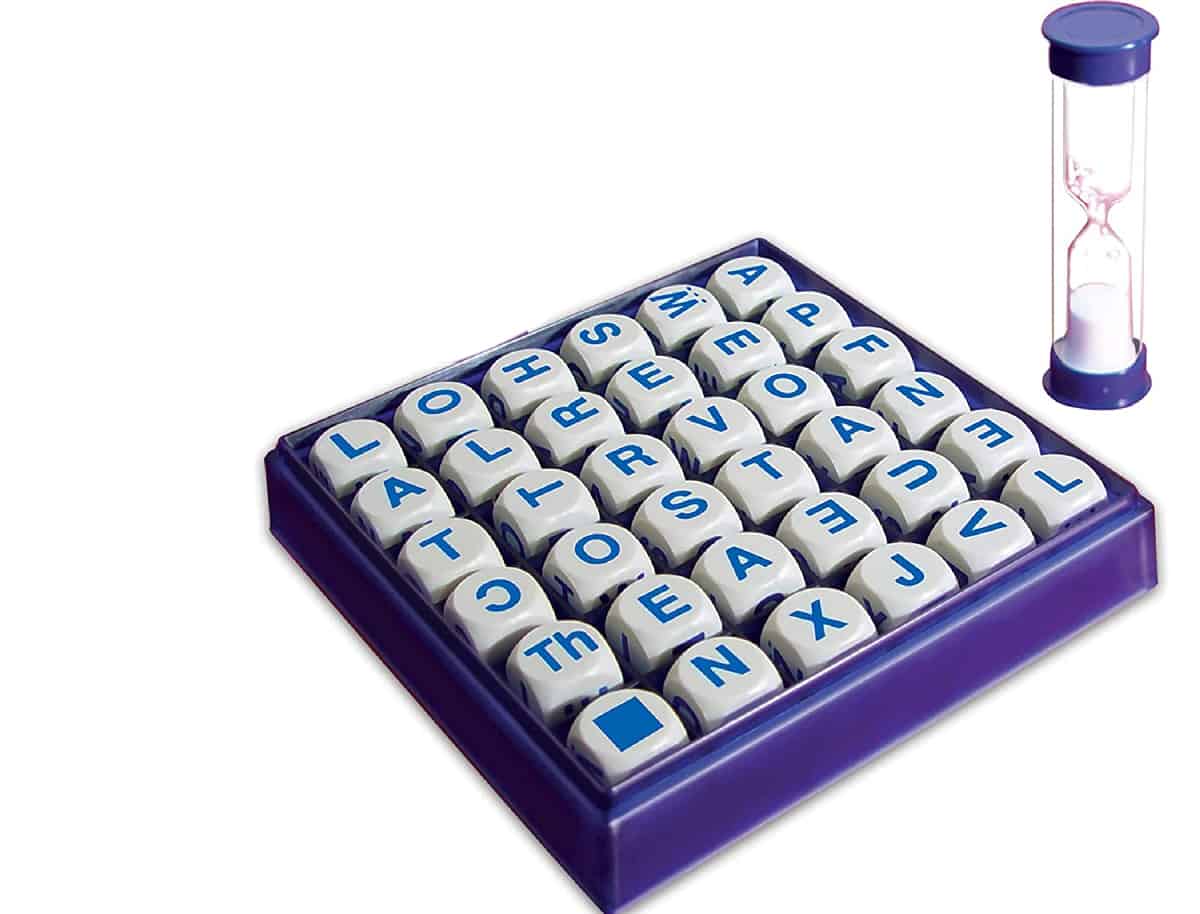
★★★☆☆
For Families| Age 8+ | Age 2-8 players
Super Big Boggle is the biggest version of Boggle. It has
is the biggest version of Boggle. It has
- A 6 x6 cube grid with dome
- 36 letter dice which represent 222 letters
- A double letter cube which features 6 most common 2-letter pairings
- 4-minute sand timer
- A special blank dice
- Instruction guide
Similar to Big Boggle, it has a double letter dice that features letter combinations such as Qu, He, In, An, Th and Er.
A few tweaks in the gameplay include:
- Minimum word size is 5-letter word
- The timer is set to 4 minutes
- The blank dice prevents players from connecting letters or forming words (they are called word stoppers)
I like this iteration because it can accommodate 2-8 players but just the same, players reap the same benefits such as
- learning to spell the words correctly
- Expanding active vocabulary by identifying 5 letter words or more.
Because of its size, I think it is a good game to introduce to children aged 8 years old and up (without the word stopper which can frustrate them).
Campbell’s Alphabet Dice Game (Wood Expressions, Inc)

★★★☆☆
For Families| Age 8+ | Age 2-6 players
Campbell’s Alphabet Dice Game is a Campbell’s soup – inspired word dice game. It has 36 letter dice.
is a Campbell’s soup – inspired word dice game. It has 36 letter dice.
Each round is called a “Serving”. Players are given equal number of dice each. They compete in building words in crossword fashion style until one player runs out of dice. The first player to use all the dice wins the round.
The object of the game is to get the lowest score possible after 4 rounds. However, players must be careful on the 4th round because the score is counted double.
Black letters count one point and red letters 2 points.
Players may roll the dice if stuck on a letter (It is called re-heating)
I find this set cool because the dice are very readable, the opportunity to build longer words is high (in fact, players can build sentences aside from words), and you can create your own rules or games like unscrambling letters to form words.
Fishing for Words (University Games)
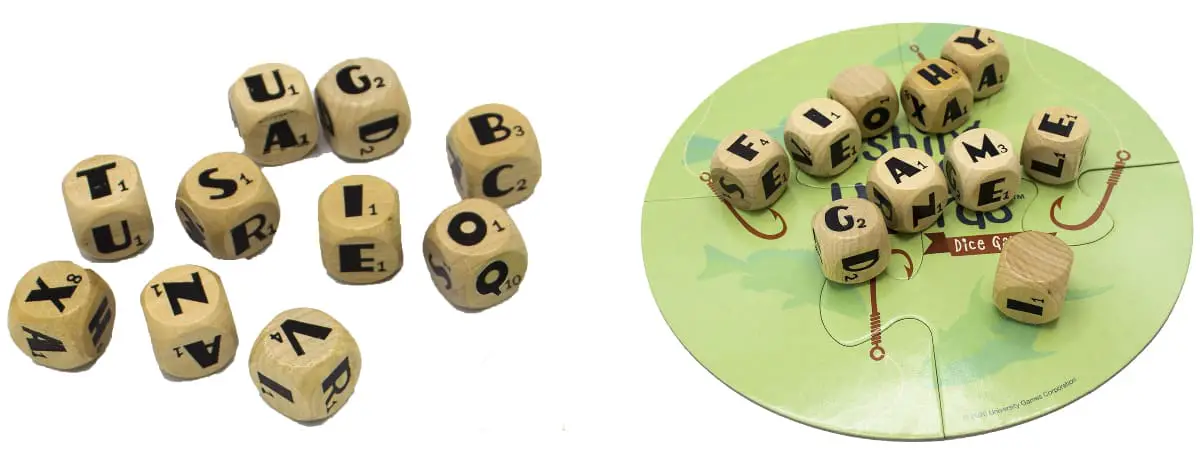
★★★☆☆
For Families | Age 8+ | Age 2-4 Players | Author: Jim Keifer
In Fishing for Words, players have five chances to create a high scoring word after rolling the dice. Players take turns in using the remaining dice to build a word that they can connect to the previously played word. After five rounds, the player or the team with the highest score wins the game.
players have five chances to create a high scoring word after rolling the dice. Players take turns in using the remaining dice to build a word that they can connect to the previously played word. After five rounds, the player or the team with the highest score wins the game.
This game contains
- 10 wooden dice
- Dice mat
- Score pad
- Rules
The good points of this game include:
- The gameplay is fast-paced and easy to follow
- The dice look neat and durable
- Scoring is easy because the player who fails to come up with a word automatically loses (I think that’s fair even for beginners, they can quickly move on and try again)
Roll A Word (Junior Learning Inc)

★★★★☆
For Families and Teachers | Age 4-9 | Age 2 Players
Roll a Word does not come with instructions but there are plenty of activities that can be made from its 10 dice which include:
does not come with instructions but there are plenty of activities that can be made from its 10 dice which include:
- Identifying letters
- Practicing spelling CVC, CVCC and CCVC words
The preferred gameplay is rolling the dice and grouping the upper faces of the dice to form a word.
However, to make the game more engaging for children aged 4 to 6 years old, you can set five rounds and give them a chance to roll the dice twice before forfeiting their turn.
There are great points for education:
- The letters on the dice are colorful, attractive and readable
- The double letter dice feature letters that are helpful in word formation like:
- Consonant digraphs (for example, ch, sh, ff)
- Vowel digraphs (ee, ea, oi)
- R-controlled vowels (ar, er, ur)
This is ideal for one-on-one sessions. I wish the set was bigger so that it can be used in larger groups in the classroom.
Word for Word (Learning Resources)
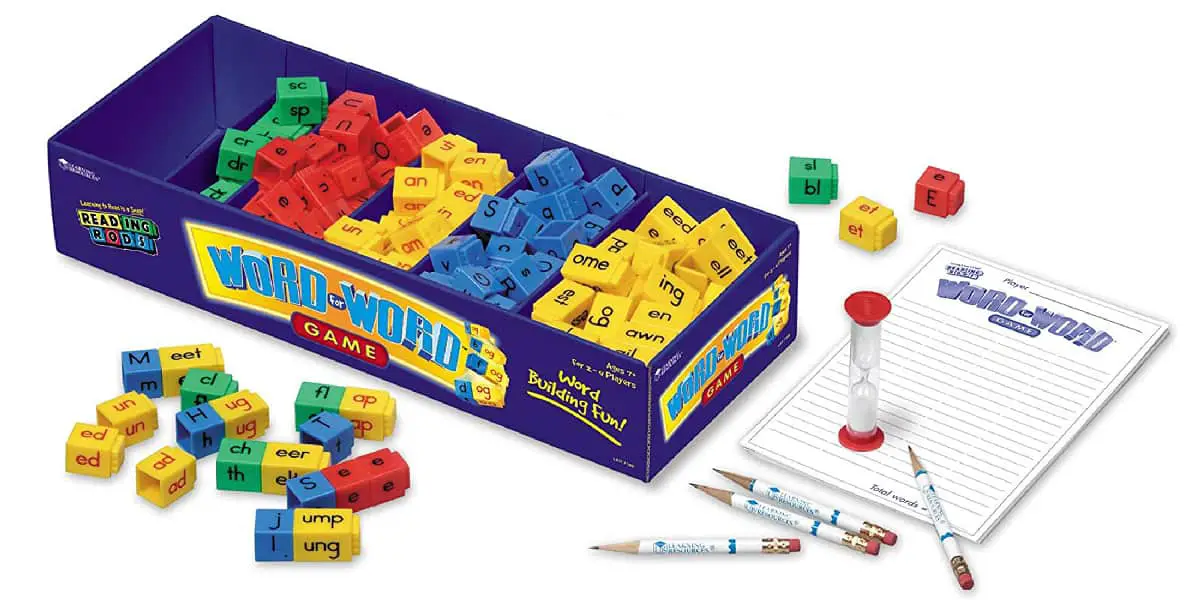
★★★★★
For Teachers| Age 7+| 2-4 Players
In Word for Word , players have 2 minutes to list as many unique words as they can make from the selected reading rods. The player with the greatest number of uncommon words is the winner.
, players have 2 minutes to list as many unique words as they can make from the selected reading rods. The player with the greatest number of uncommon words is the winner.
This game is composed of
- 112 color-coded rods
- Two-minute Timer
- 4 pencils
- Score pads
- Instructions
The game play is a bit similar to Boggle. Rods have the peculiarity that you can use 4 different faces per rod (versus 6 on dice), and that you can connect the rods.
The main attraction is the availability of the following reading rods:
- 31 blue consonant rods
- 21 red vowel rods
- 18 yellow with red print word families rods
- 29 yellow with black print two-letter and three letter word endings
- 9 green beginning and ending blends
- 4 blank replacement rods
There are five levels of gameplay and here’s how to set them up:
- Level 1 (Easiest): Use 4 yellow rods (red print) and 6 blue rods
- Level 2: Connect 4 yellow rods (black print) and 6 blue rods
- Level 3: Group 2 green rods, 3 yellow (Black print) rods, 3 yellow (red print) rods and 4 blue rods
- Level 4: Select 2 green rods, 2 yellow (black print) rods, 2 yellow (red print) rods, 4 blue rods and 2 red rods
- Level 5 (Hardest): Use 2 green rods, 2 yellow (black print) rods, 6 blue rods, and 4 red rods
For young players, the game guide recommends starting with:
- 4 blue rods and 2 red rods or
- 3 blue rods and 3 yellow (red print) rods
Moreover, the game guide listed several variations and rule modifications, so check them out as well.
The things I like about this game are:
- There is progression (players can feel their improvement because there are five game levels to try)
- It offers unique tactile experience of checking all the sides of the rods to get all possible word combinations, writing the words on a pad and breaking apart the rods before passing them to the next player
- The pieces are appealing to children because it reminds them of Lego and other blocks game
Unlike most games that require students to make a mental note of the spelling of words, this set presents a memory-enhancing experience of constructing words with physical rods and themes like
- Using blends, digraphs, rhymes and more
- Controlling word lengths, starting letters and word endings
I recommend playing this game
- on one-on-one session with young children aged 7 to 9 years old
- with 2-4 players if they are independent learners, presumably aged 8 years old and up.
Word Spin (Geospace)
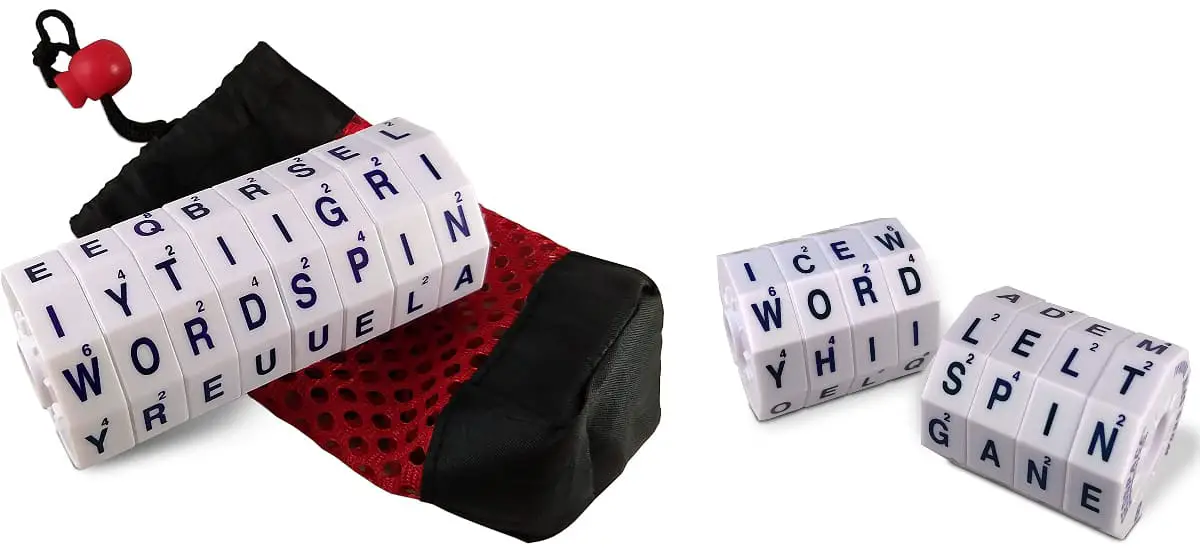
★★★★★
For Families | Age 8+ | Age 2-10 Players
Word Spin contains 8 magnetic wheels with 10 letters each.
contains 8 magnetic wheels with 10 letters each.
Players take turns rearranging the wheels and spinning them to create high scoring words. Each letter carries a numerical value and the player with the highest score wins the round.
Aside from this gameplay, the game guide lists instructions for 10 different games that players can enjoy using these rotating wheels.
I like that:
- The wheels are compact and easy to secure in a bag
- Children find the magnetic wheels amusing so encouraging them to find words is easy
- Challenging students to build words composed of 2 letters to 8 letters is possible
- Themes can be introduced to target vocabulary
- Can be played alone or up to 10 players
It can also be used in treasure-hunting or detective-themed games.
Overall, Word spin offers a lot of fun and freedom in word building.
Word Board Games
Blank Slate (Goliath Games)

★★★☆☆
For Families| Age 8+ | 3-8 Players
Blank Slate is a party game comprised of
is a party game comprised of
- 250 double-sided word cue cards
- 8 write and wipe slates
- 8 dry erase markers
- Instruction guide
- A scoreboard
The object of the game is to fill in the missing word in the cue card and their answer must match with one player but not all players. Points are given to players that have matching answers. The first player to reach 25 points wins the game.
I like the gameplay because it is easy to learn. However, predicting another player’s answer is difficult.
Other good points of this game include:
- Children enjoy writing on write and wipe boards
- Scoring is easy (players can track their achievement)
- Encourages interaction among players
Despite the fun this game offers, I have a few suggestions:
- If played with children, adults should be careful about their answers. Otherwise, some cue cards are not appropriate for young players.
- Setting a timer will speed up the game and make it more challenging for advanced players.
- For beginners, sorting the cards first or making up new categories will make the game more enjoyable for them.
All in all, this game stimulates interest in listening to what other people have on mind. It is a good family game.
Word Search (Goliath Games)
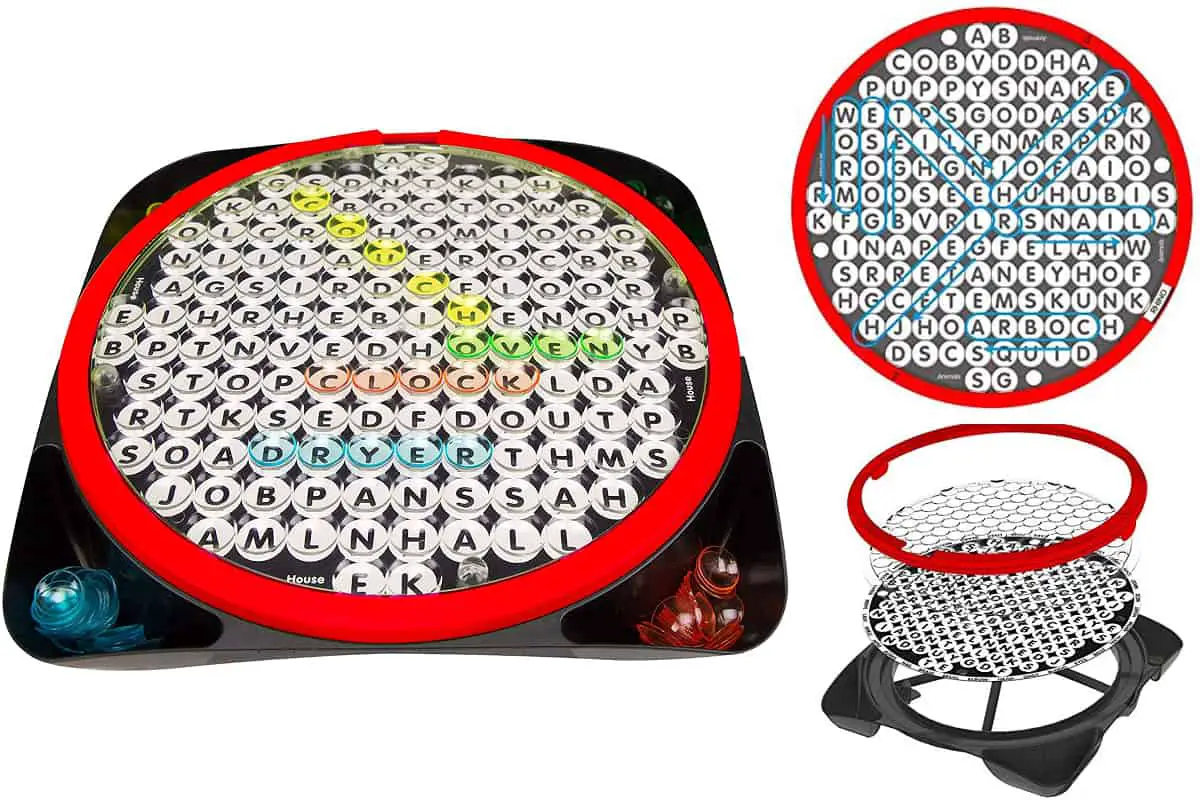
★★★☆☆
For Families| Age 7+ | Age 2-4 players
In Word Search, players race to find on the circular gameboard the target word revealed at the bottom. The player who successfully finds the word places colored markers on top of the letters. The player with greatest number of colored tiles wins the game.
players race to find on the circular gameboard the target word revealed at the bottom. The player who successfully finds the word places colored markers on top of the letters. The player with greatest number of colored tiles wins the game.
This game contains
- 8 double-sided game cards that contain 16 puzzles (a total of 464 words to search)
- a circular gameboard
- 280 colored marking tiles
At the start of the game, each player picks a color to determine the markers that will be used throughout the game.
“Word serach” opens opportunities to learn unfamiliar words and look for their meanings after the game.
Other Word Tabletop Games
Blends Dominoes (Junior Learning Inc)

★★★☆☆
For Families | Age 5-6 | Age 1-2 players
Blends Dominoes is a domino matching game suitable for children aged 5-6 years old.
is a domino matching game suitable for children aged 5-6 years old.
It contains a tin storage and 28 plastic dominoes that are designed for helping children to read, spell and learn blend words.
The pros of this game are:
- There are cute illustrations that serve as clues for answers
- Encourages players to read aloud or produce the sounds of the words they create
I recommend this game for developing basic phonetic skills.
Tapple (Rejects from Studios)
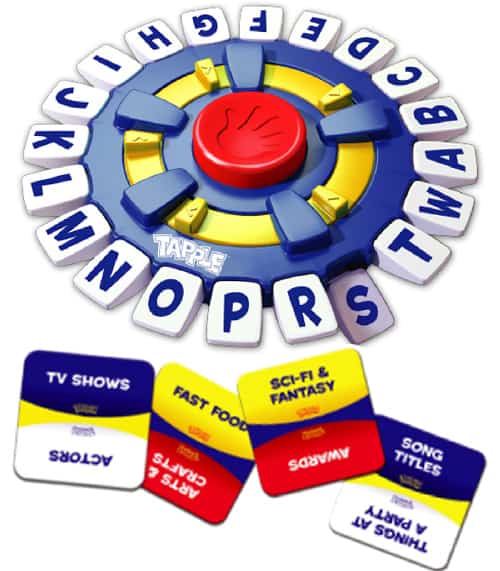
★★★☆☆
For Families| Age 8-up | Age 2-8 players
Tapple gives players 10 seconds to provide an answer according to a category. The game involves three actions:
gives players 10 seconds to provide an answer according to a category. The game involves three actions:
- Say the answer
- Press or tap the letter key
- Reset the Timer at the center
To win, players must collect three category cards. A category card is given to the last player left in each round.
This game contains 36 double-sided theme cards and a Tapple wheel. The timer needs a double A battery but it is not included in the game set.
Here are some pros and cons:
- 144 categories to choose from (two categories on each card side which can be sorted according to difficulty)
- Compact (cards can be stored at the back of the wheel)
- The timer adds pressure and fun (not good for beginners though)
- it encourages word rapid recall (difficult to validate answers because time is running)
- Players cannot concentrate (they have to pay attention to the letters used at the same time think of their answer)
- Rules can be changed
- can decide how many rounds to play
- if players are familiar with the categories after several gameplays, ask players to name 2-3 answers in 10 seconds
- Can be played alone or with 2-7 players (if played with 5 or more players, the wheel is passed around instead of rotating it at the center)
I recommend this game to practice existing vocabulary and learn new words according to categories.
Word Witt (Darling LLC)

★★★☆☆
For Families | Age 7+ | Age 1-4 Players | Author: Carrie Chapie
In Word Witt , players flip a card and roll the dice to create as many word combinations as possible within the time limit. Players write their words on a scratch paper pad.
, players flip a card and roll the dice to create as many word combinations as possible within the time limit. Players write their words on a scratch paper pad.
This game contains
- 1 minute-timer
- 3 vowel dice
- Consonant cards
- Score pad
- Scratch paper pad
- Instruction booklet
The unique thing about the card set is that it contains consonants on cards while the dice contain vowels.
There are two ways to score points in this game:
- Quick scoring method
- Words with 1-4 letters are equivalent to 1 point
- Words with 5+ letters gain 2 points
- High stakes scoring method
- 4 letter word- 1 point
- 5 letter word- 2 points
- 6 letter word- 3 points
- 7 letter word- 4 points
- 8 letter word- 5 points
Players get additional 5 points if they were successful in using all 3 vowels in one word.
As for variation, I suggest
- Introducing a category to make the game challenging
- Extending the time limit for vocabulary-challenged players
- Asking players to use the consonants either as starting letters or ending letters
I like the story behind the creation of this game. Carrie Chapie invented the game to help her first child who suffers from dyslexia. I think she is amazing in coming up with a good game that can help struggling parents like her.
In the end, she was able to produce a game that:
- Is a great resource for students working on phonemic awareness skills
- Is Helpful in spelling and vocabulary
Other Types of Tabletop Games
If you are interested in other tabletop games, I recommend visiting the following posts:
- 12 Vocabulary Board Games for Schools and Families

- 14 Vocabulary Card Games from Pre-kindergarten to Elementary

- 23 Alphabet Board Games & Toys for Pre-K Children

- 13 Magnetic Alphabet Fishing Games for 2-to-5-year-olds

Edudingo.com is a participant in the Amazon Services LLC Associates Program, an affiliate advertising program designed to provide a means for sites to earn advertising fees by advertising and linking to Amazon.com. We also participate in other affiliate programs which compensate us for referring traffic.

